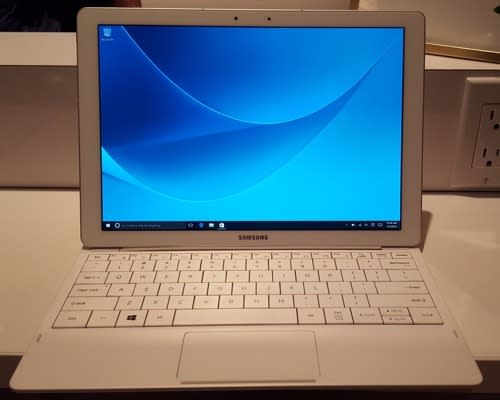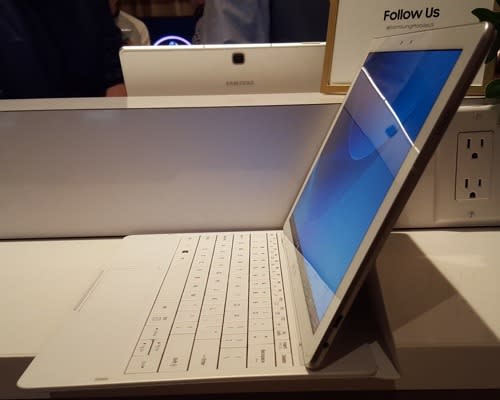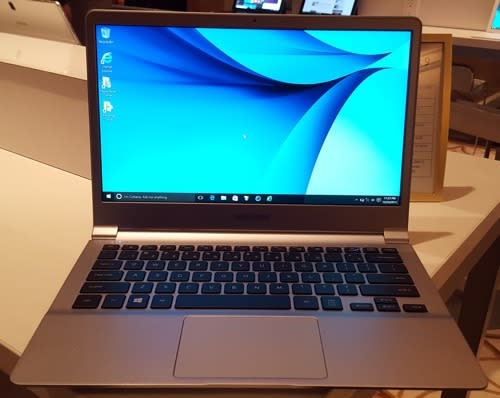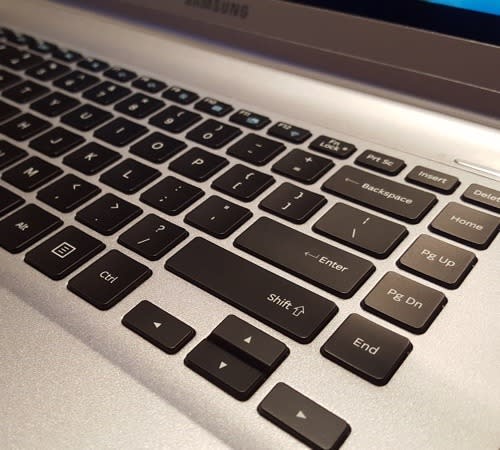Samsung Goes After Microsoft and Apple With Its New Win 10 Tablet and Laptops

Microsoft might want to keep an eye on Samsung: The Korean tech giant today announced a new Windows 10 productivity tablet that will compete directly with the Windows maker’s Surface Pro slate.
On top of that, Samsung also showed off a pair of 13- and 15-inch laptops that are so light you’d swear they’re just empty shells rather than fully functional notebooks.
A Surface fighter in the making
The Samsung TabPro S is a 12-inch tablet that runs full versions of Microsoft’s Windows 10 Home or Windows 10 Pro. To say this thing is slim is an understatement: Measuring 11.5 x 7.8 x 0.24 inches and weighing just 1.5 pounds, the TabPro S is thinner and lighter than the Surface Pro 4.
Heck, it’s even thinner than Apple’s 13-inch iPad Pro.
Related: More coverage of CES 2016.
Notably, the TabPro S doesn’t use a micro-USB connector; instead it has a new USB Type-C port, which it uses for both power and video. Samsung says it will offer a separate dongle for connecting the tablet to an external monitor, so you can use the TabPro S as a makeshift workstation.
Beyond its svelte frame, the TabPro S’s showstopping feature is its gorgeous 12-inch screen. With its Super AMOLED display (it’s the first Windows 10 machine to have one), colors really pop.
I didn’t get to see any movies playing on the TabPro S. But based on how the Windows desktop screen looked, I’m fairly confident they’ll look equally impressive.
The TabPro S comes wrapped in a magnesium body, with a magnetic rear that connects with the included keyboard case. That’s right: Unlike Microsoft and Apple, which both make you buy their keyboards separately, Samsung is actually including a keyboard with its productivity slate.

Unfortunately, that keyboard’s keys felt a bit stiff during my brief typing test, and some keys didn’t register my inputs. The keyboard case’s two-stage hinge also felt a bit flimsy when I was using it. Ideally, Samsung will address these issues before the tablet hits the market.
Inside, the TabPro S packs an Intel Core M processor, 4 GB of RAM, and 128 GB of storage. For basic word processing and Web browsing, the Core M processor should be fine, but if you need to do anything more demanding, the Core M might not be enough machine for you.
Unfortunately, Samsung doesn’t offer the option to upgrade the TabPro S to a faster processor. That’s because the tablet is built around a fanless design; a more powerful processor would require a fan to keep the tablet cool.
On that count, the Surface Pro wins. While the base version of the Surface also comes equipped with a Core M processor, you have the option of upgrading to a faster Core i5 or even a Core i7 processor. So if you want serious performance from your Windows 10 tablet, you’ll be better off with the Surface Pro.
A ridiculously lightweight laptop
In addition to the TabPro S, Samsung also introduced its ultralightweight Book 9 13-inch and 15-inch laptops.
The 13-inch is the star of the show, thanks to its ridiculously lightweight 1.85-pound design. That makes the Book 9 the lightest 13-inch notebook in the world, beating out Lenovo’s LaVie Z. It’s even lighter than Apple’s super-small 12-inch MacBook. I really can’t stress how light the Book 9 feels: I’ve held empty dinner plates that feel heavier than this laptop.

The Book 9 isn’t just lightweight — it’s also incredibly thin. At 0.53 inches thick, it’s a hair thicker than the MacBook (0.52 inches) but thinner than the LaVie Z (0.70 inches).
To make the Book 9 so thin and light, Samsung built it with a magnesium body. It feels completely solid, particularly compared to Lenovo’s flimsy-feeling LaVie Z. The Book 9 is stable and doesn’t flex when you push down on it.
The Book 9 comes with a 13.3-inch 1920 x 1080 resolution display. While I didn’t have time to thoroughly view movies or photos on the screen, on first glance it was certainly colorful and bright.
In terms of performance, the 13-inch Book 9 can be outfitted with up to an Intel Core i7 processor, 8 GB of RAM, and 256 GB of storage. For inputs, it gets two USB 3.0 ports, a micro-HDMI slot, mini Ethernet, mini VGA, and a three-in-one media card reader.

While heavier, the 15-inch Book 9 isn’t too shabby either. Its 2.84-pound body feels just as impressively solid as its 13-inch sibling’s, and it packs the same high-powered components. The biggest difference between the two laptops, beyond their screen sizes, is that the 15-inch Book 9 comes with a USB Type-C port, which is faster and more versatile than standard USB ports.
Samsung hasn’t provided any information on pricing or availability for the 13-inch or 15-inch Book 9, but we’ll keep you updated when we find out more. Stay tuned.
Email Daniel at dhowley@yahoo-inc.com; follow him on Twitter at @DanielHowley or on Google+.
More from CES 2016:
HTC and UnderArmor’s HealthBox is an All-in-One Fitness Tracking System
HTC Debuts Improved Vive Pre VR Headset with Front-facing Camera
Toyota Spending $1 Billion to Develop AI-Driven Cars, Robots for the Home
Ford Says It Will Have Self-Driving Cars and Smart-Home Integration by 2020
4 Big Trends at CES 2016: Cars, Wearables, Laptops, and Accessories for Everything
LG’s See-Through, Rollable OLED Screens: Here, But Not Cheap
Meet CleverPet, the Electronic Game That’s Like ‘Simon’ For Dogs

